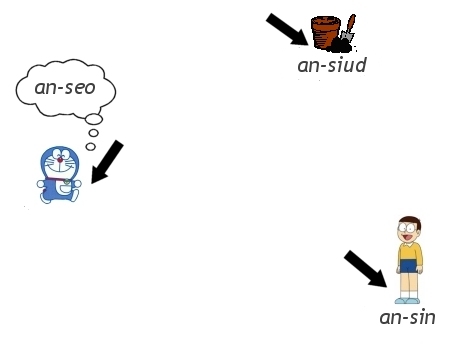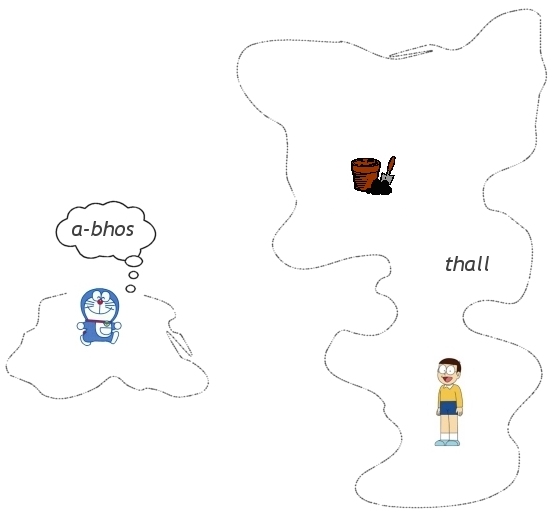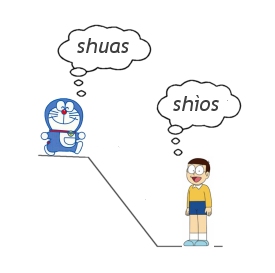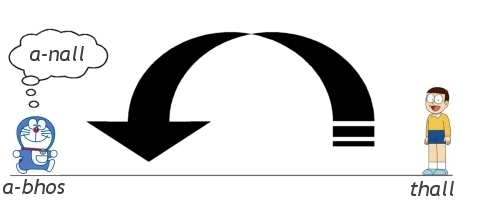An diofar eadar na mùthaidhean a rinneadh air "Adverbs or Thall 's a-bhos"
| (Rinn an cleachdaiche 2 mhùthadh eadar-mheadhanach nach eil 2 'gan sealltainn) | |||
| Loidhne 38: | Loidhne 38: | ||
You can combine them to emphasise the "over here" or "over there" bit: <span style="color: #008000;">a-bhos an-seo, thall an-siud, thall an-sin</span>. | You can combine them to emphasise the "over here" or "over there" bit: <span style="color: #008000;">a-bhos an-seo, thall an-siud, thall an-sin</span>. | ||
| − | The fun | + | The fun starts when you realise that Gaelic distinguishes between location and motion and has corresponding adverbs: |
{| style="width: 75%;" border="0" align="center" | {| style="width: 75%;" border="0" align="center" | ||
| Loidhne 54: | Loidhne 54: | ||
|} | |} | ||
| − | + | And fun get's even better - you have to watch out whether a movement is away from the speaker or towards him. If you're downstairs, and your cat is running up the stairs trying to get away from you, she is going <span style="color: #008000;">suas</span> [suəs]. If you're standing on top of the stairs and Tiddles is zooming up the stairs, towards you, she is coming <span style="color: #008000;">a-nìos</span> [əˈniəs]. | |
| − | And the other way round - if your | + | And the other way round - if you're at the top of the stairs and your cat is running away from you, down the stairs, she is going <span style="color: #008000;">sìos</span> [ʃiəs]. But, if you're at the bottom of the stairs and Tiddles is falling down the stairs towards you, she is coming <span style="color: #008000;">a-nuas</span> [əˈnuəs]. Confusingly, some dialects have merged <span style="color: #008000;">a-nuas</span> and <span style="color: #008000;">a-nìos</span> into <span style="color: #008000;">a-nuas</span>, in which case <span style="color: #008000;">a-nuas</span> stands for 'movement towards you either upwards or downwards'. |
| − | Confusingly, some dialects have merged <span style="color: #008000;">a-nuas</span> and <span style="color: #008000;">a-nìos</span> into <span style="color: #008000;">a-nuas</span>, in which case <span style="color: #008000;">a-nuas</span> stands for 'movement towards you either upwards or downwards'. | ||
It may help to think of them as <span style="color: #008000;">*an-shìos</span> and <span style="color: #008000;">*an-shuas</span>, from below and from above, which is where these words originally come from. That's also the reason why the <span style="color: #008000;">n</span> at the beginning of <span style="color: #008000;">a-nuas</span> and <span style="color: #008000;">a-nìos</span> are weak as if they were word medial or final - because they originally were stuck at the end of <span style="color: #008000;">an-</span>. | It may help to think of them as <span style="color: #008000;">*an-shìos</span> and <span style="color: #008000;">*an-shuas</span>, from below and from above, which is where these words originally come from. That's also the reason why the <span style="color: #008000;">n</span> at the beginning of <span style="color: #008000;">a-nuas</span> and <span style="color: #008000;">a-nìos</span> are weak as if they were word medial or final - because they originally were stuck at the end of <span style="color: #008000;">an-</span>. | ||
Am mùthadh mu dheireadh on 05:00, 13 dhen t-Sultain 2013
Fascinating topic ... although linguists will tell you that Gaelic is actually quite boring in terms of its adverbial system. For example, Caucasian languages make a distinction of whether the object in question is higher, lower, or on the same level as you and whether it's visible or hidden from view. But I digress.
To start with, Gaelic distinguishes three spatial locations: proximal, medial and distal. Which in human means something that's close to the speaker, something that's close to the addressee, and something that's remote from either. Luckily, Doraemon has agreed to help us out with an example:
Why the arrows? Because an-seo [əˈʃɔ], an-sin [əˈʃin], and an-siud [əˈʃid] are quite 'specific' in their reference. When you use them, you're making a clear statement about where something is. These three vary quite a bit in their pronunciation, so here's an overview:
| an-seo | an-sin | an-siud |
| [əNʲˈʃɔ] | [əNʲˈʃin] | [əNʲˈʃid] |
| [əˈʃɔ] | [əˈʃin] | [əˈʃid] |
| [ənəˈʃɔ] | [ənəˈʃin] | [ənəˈʃid] |
| [ənəˈhjɔ] | [ənəˈhin] | [ənəˈhid] |
What's the difference? The first line is definitely careful speech, the second normal/colloquial, and the third and fourth just colloquial variants.
The above remark about being specific is important because Gaelic has another set of adverbs which are the exact opposite, thall [hauL] and a-bhos [əˈvos]:
Slightly exaggerated but that's essentially the difference - thall is the space some way away from the speaker but with no specification of how far or where in location to the person addressed. A-bhos is similarly vague, so they often get translated "by over here, hereabouts" and "over there, thereabouts".
You can combine them to emphasise the "over here" or "over there" bit: a-bhos an-seo, thall an-siud, thall an-sin.
The fun starts when you realise that Gaelic distinguishes between location and motion and has corresponding adverbs:
Shuas [huəs] and shìos [hiəs] are simply adverbs of location - nobody is moving.
And fun get's even better - you have to watch out whether a movement is away from the speaker or towards him. If you're downstairs, and your cat is running up the stairs trying to get away from you, she is going suas [suəs]. If you're standing on top of the stairs and Tiddles is zooming up the stairs, towards you, she is coming a-nìos [əˈniəs].
And the other way round - if you're at the top of the stairs and your cat is running away from you, down the stairs, she is going sìos [ʃiəs]. But, if you're at the bottom of the stairs and Tiddles is falling down the stairs towards you, she is coming a-nuas [əˈnuəs]. Confusingly, some dialects have merged a-nuas and a-nìos into a-nuas, in which case a-nuas stands for 'movement towards you either upwards or downwards'.
It may help to think of them as *an-shìos and *an-shuas, from below and from above, which is where these words originally come from. That's also the reason why the n at the beginning of a-nuas and a-nìos are weak as if they were word medial or final - because they originally were stuck at the end of an-.
But let's move on. We still have to deal with movement in the thall and a-bhos arena:
Pronounced a-nall [əˈnãũL] and a-null [əˈnũːL]. Assuming that, as explained above, a-bhos and thall are considered "fuzzy" concepts. A-nunn [əˈnũːN], which you will sometimes see is just a variant of a-null.
That's it.
Err ... not quite, as we've had a question about a-bhàn "down" (motion) and an-àird "up" (motion). This used to be a question of Mainland dialects (which used a-bhàn and an-àird) and Island Dialects (which use the above system). Today it's a stylistic question - a-bhàn and an-àird definitely being the marked terms. A "marked term" means that it's less common and sounds something between off and posh when you use one, although an-àird is more acceptable than a-bhàn.
| Beagan gràmair | ||||||||||||
| ᚛ Pronunciation - Phonetics - Phonology - Morphology - Tense - Syntax - Corpus - Registers - Dialects - History - Terms and abbreviations ᚜ | ||||||||||||






